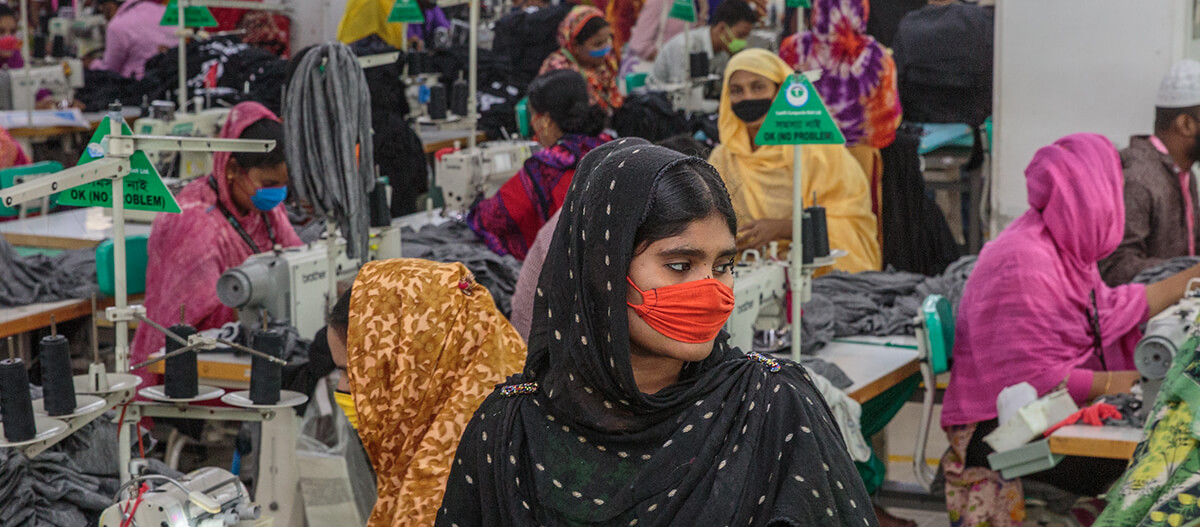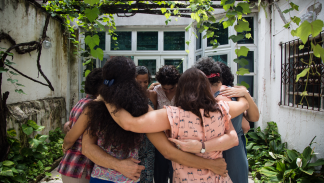ACROSS BORDERS: How Advocates for Workers' Rights Are Collaborating to Change the World
Across borders, we know that women working in the garment industry experience sexual harassment, verbal abuse, and even assault at work. While the contexts in each country are unique, in India, Cambodia, Vietnam, and Bangladesh, Global Fund for Women’s grantee partners working in our Ending Gender Based Violence Against Garment Workers initiative have identified common challenges in ensuring work environments are safe for women, including lack of legal protections and lack of effective or well-known mechanisms for reporting harassment.
One of the most fundamental challenges reported by our grantee partners is that women garment workers often don’t know their rights and often cannot identify what constitutes sexual harassment. “When we started working with women garment workers, we realized many women didn’t even know about the laws protecting them,” says Elizabeth Khumallambam of Nari Shakti Manch in India, one of Global Fund for Women’s grantee partners working on the initiative.
“When we interview [garment workers,] they don’t understand what sexual harassment means. They know that rape is sexual [violence]…but they don’t think that whispering or unwanted touching is sexual harassment,” says Nguyen Phuong Thuy of ActionAid Vietnam, a grantee partner.
Grantee partners also note that even if workers recognize what they’ve experienced as sexual violence, many are unwilling to report it. Survivors may be identified as “problem workers” or experience shame or victim-blaming. “In patriarchal countries like Vietnam, men always think that they have the right to ask women to do something, and if someone experiences sexual harassment they blame the women for the way they were wearing their clothes,” says Nguyen Phuong. “They say ‘You were raped because you were wearing a short dress’ or something like that.”
Survivors may be socially stigmatized for reporting, and many aren’t willing to risk it. “If a woman files a complaint, some of the people from her hometown or her neighborhood will naturally come to know about it,” says Elizabeth Khumallambam of Nari Shakti Manch. “Say the woman is married and has a daughter; when word spreads that this has happened to the mother, it becomes a question of ‘Now who will marry my daughter?’ Or others have experienced that their family might become suspicious of them. They say ‘My husband might ask me “Why is it only happening to you, why is it not happening to other women?”’ That is the reason that she does not want to open up or not fight openly about this kind of issue.”

While our grantee partners are prioritizing helping garment workers understand their rights at work and identify sexual violence or harassment when they experience it at work, they’re also aware that addressing violence at work is just the tip of iceberg. Not only are patriarchal societies more likely to shame or condemn sexual abuse survivors who report their experience, but workers also say that their experiences of violence are certainly not limited to the factory floor. Many workers report being harassed on the way to or from work, some are attacked outside of work property, and still others experience violence at home. While this initiative is focused on the world of work, the issues garment workers face are part of a broader experience. “The work of our grantee partners in addressing gender based violence inside the garment industry can be a catalyst for change more broadly in society where such violence is also perpetrated, rationalized, and often tolerated. As the women in garment factories and others not only begin to understand and advocate for their rights and seek redressal mechanisms, it can also change the paradigm of the culturally accepted forms of this violence,” says Sangeeta Chowdhry, Global Fund for Women’s Program Director for Economic Justice, who is leading this initiative. “What will also go a long way I think towards institutional accountability, will be the much anticipated passage this year of a new Convention from the International Labor Organization, defining what constitutes violence and harassment in the workplace,” she continues.
Through the garment workers’ initiative, Global Fund for Women is connecting grantee partners and providing opportunities for groups to share learnings, strategies, and collaborate on common issues—and help convince factory leaders that the issue is worthy of attention. As part of the initiative, Global Fund for Women hosted a convening in Dhaka, Bangladesh, bringing together our grantee partners from the four countries, along with other allies working on the issue, for peer learning and strategizing. Working with other groups, “You realize it’s not just a Bangladesh-specific issue,” says Maheen Sultan of Naripokkho in Bangladesh. “We’re facing similar problems in Cambodia, Vietnam, India. By working with Vietnam and Cambodia it will also help our industries [in Bangladesh] realize that we’re not blaming them only—it’s a worldwide issue. We can point to the fact that other countries are taking steps to recognize [violence at work] and deal with it; you also need to be part of that global initiative. It gives it much more of a weight.”
We’re facing similar problems in Cambodia, Vietnam, India. By working with Vietnam and Cambodia it will also help our industries [in Bangladesh] realize that we’re not blaming them only—it’s a worldwide issue. We can point to the fact that other countries are taking steps to recognize [violence at work] and deal with it; you also need to be part of that global initiative. It gives it much more of a weight.”Maheen Sultan


